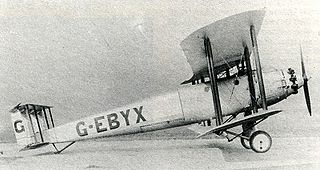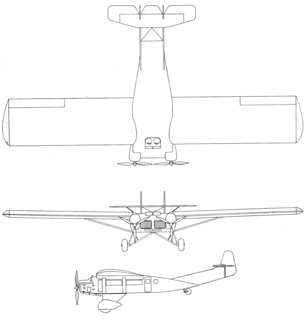
The Aero Letňany A.10 was a biplane airliner produced in Czechoslovakia shortly after World War I. It was the first commercial aircraft to be built in Czechoslovakia and was known as the Ae-10 Limousine. It was designed by Husnik and Vlasak and was intended to meet the growing need for aerial communication to and from the country. Behind the single nose-mounted engine was a cabin with seats for three and two tables, upholstered on the underside, and able to be inverted to provide another two seats if required. A double skinned firewall between the engine and cabin, together with double skinned surfaces to the walls, floor and roof and Triplex windows gave a (relatively) quiet ride. A rear window gave communication with the pilot, whose open cockpit was above and behind the cabin. The cockpit also accommodated the navigator who had a seat directly behind the pilot.
The Aero A.23 was a Czechoslovakian airliner of the 1920s. Aero Vodochody had produced the first Czech airliner, the A.10, four of which had served with ČSA, the national airline. The A.23, another biplane, was bigger, more powerful and could carry more passengers.

Vincent Justus Burnelli was an American aeronautics engineer, instrumental in furthering the lifting body and flying wing concept.

The Burnelli CBY-3 Loadmaster is an unconventional transport aircraft that was designed by American engineer Vincent Burnelli and built in Canada in 1944 by Canadian Car and Foundry.

The Burnelli UB-14, also known as the Cunliffe-Owen Clyde Clipper, was a 1930s American prototype lifting-fuselage airliner designed and built by Vincent Burnelli.

The Vickers Vellore was a large biplane designed as a freight and mail carrier, in single-engined and twin-engined versions, which saw limited use as freighters and long-range experimental aircraft. A final variant with a broader fuselage, the Vellox, was built as an airliner.
The Fisher Youngster is a Canadian single-seat, conventional landing gear, single-engined, biplane kit aircraft designed for construction by amateur builders. The aircraft was inspired by the German Bücker Bü 133 Jungmeister aerobatic aircraft of the 1930s.
The Junkers J 15 was an all-metal monoplane built in Germany in 1920 to explore the design parameters of small single-engined passenger transports. In particular, it could fly in either high or low wing configurations. It led to the Junkers J 16 light airliner.

The Bellanca CF is an early enclosed high-wing monoplane designed by Giuseppe Mario Bellanca that led to a successful series of Bellanca aircraft. Bellanca was nominated for the Collier Trophy in 1922 for the CF design.

The SAB AB-20 was a large four engine twin boom French bomber built in the early 1930s as a development of the Dyle et Bacalan DB-70 airliner. It featured a lifting body of thick airfoil section between the inner engines. It was later modified for the attack role; a second aircraft, the AB-21, had different engines and cleaner aerodynamics but no more were built.

The Burnelli CB-16, also known as the Uppercu-Burnelli CB-300, was a passenger aircraft designed by the American company Burnelli in 1928. It was the first twin-engined aircraft to have retractable landing gear. Only one was built.

The Burnelli GX-3, also known as Uppercu-Burnelli UB-SS. was an American twin-engined, mid-wing experimental aircraft which first flew in 1929. Work commenced on this aircraft during development of the Burnelli CB-16. Soon after, Daniel Guggenheim announced the Guggenheim Safe Aircraft Competition. Many manufacturers brought aircraft to this competition. The GX-3 was built in New Jersey, but did not arrive at the competition in time to participate. However, it was reported to have good short take-off and landing capabilities and was able to operate at 200 km/h. The GX-3 had wings which were able to change their shape using flaps. The front wheels were smaller than the rear ones, and the aircraft was powered by two 90 hp (67 kW) engines. The pilots sat in an open cockpit. The aircraft also incorporated Burnelli's lifting-body feature.
The Friesley Falcon was a twin engine, 12 passenger biplane airliner, designed and flown in the United States in 1921. The only example built was later sold to China.
The Continental KB-1, also known as KB-1 Military Biplane or KB-1 Continental Pusher, is an early design developed by the engineer Vincent Burnelli.

The Hatz Classic is an American homebuilt biplane, designed by Billy Dawson and produced by the Makelan Corporation of New Braunfels, Texas. The aircraft is supplied as a kit or, alternatively, in the form of plans for amateur construction.

The Caudron C.33 "Landaulet Monsieur-Madame" was a French twin engined biplane with four seats, two in open cockpits and two in an enclosed cabin.

The Burnelli UB-20 was a prototype lifting body airliner designed by Vincent Burnelli and built in the early 1930s.

The 1929 Curtiss Model 53 Condor, also known as the Curtiss Model 53 Condor 18 or the Curtiss CO Condor, was a civil passenger version of the Model 52 Condor bomber. A twin-engined biplane, it carried 18 passengers.
The Kawanishi K-3 was a Japanese, fast, multi-purpose civil transport aircraft from the early 1920s. Despite its good performance it was eclipsed by the release of Army surplus machines and only one was built.















